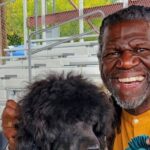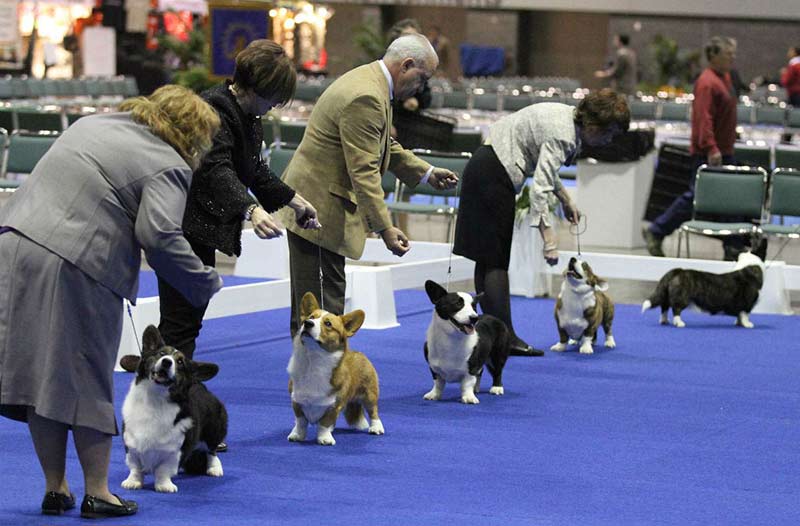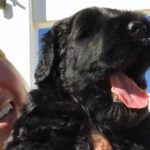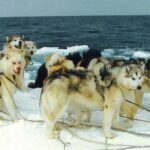The exciting part about dog shows is that there are multiple opportunities, even layers of genuine learning, that can happen both at ringside and in the ring. As a dog person, I enjoy the moments when I have the time to explore new information. I will look in the catalog to see which breeds catch my eye and who is judging them. Time permitting; I pull up a chair just as though I was in school. As often as not, I find myself seated next to someone with experience in the breed. If I’m lucky, that someone is the real deal, and I have the privilege of a genuine learning experience, where I come away with a greater appreciation for the essence of that breed.
Learning at a Dog Show at Ringside
We all know that real learning happens when we keenly observe at ringside. Ringside learning is a fundamental dog show truth. What does this look like? At its core, ringside learning is sitting ringside—watching—learning.
When I was exhibiting Rottweilers, I wanted to learn to handle better, win more, and be respected! When my usually early ring time was over, I would go by a ring with an entry where there were a lot of professional handlers. I would sit and watch every move that was made in that ring. It was like the curtain went up, and I was watching a ballet choreographed by Balanchine. Each player had their own role that was intertwined with another dancer on the stage. Each one always knew where they were in relation to the others and where s/he was in the dance. On a good day, the timing was impeccable, with each person playing their part in the ring. I was mesmerized.
One handler of note was the late Gwen DeMilta. From the moment she set foot on the show grounds, Gwen knew how to play a “mind game” with the competition. She exemplified complete focus with a steely outer comportment. She taught me how mastering the mind game and showing up with a winning mindset is even more important than learning how to handle. You can make handling mistakes and still win, but if you make mindset mistakes, it’s hard to come back from them.
In the ring, I used to watch her create a picture for the judge by “oozing” a dog together with her gentle hands. She understood what the dog should look like and made it happen. She created a work of art.
As often as not, she won (one or both) Winners Dog and Winners Bitch. Gwen would pass the dog/bitch off in Breed, and she would move on to show her special, whichever one it was. Then it all fell apart. The keen observer would be shocked to see what the class dog really looked like when it was shown by a lesser, shall we say, “mere mortal” handler, or sometimes even the owner. And that’s one way I learned to look through what some quality handlers were able to create in the ring. I have applied this as a judge many times.
Peer Mentoring as Another Layer of Learning
Once you are mesmerized by the handlers, curiosity leads you to read the standard for that breed. It is fascinating to study the words in a standard other than your own. The question to ask yourself is, “How does the studying of other standards lead to a better understanding of my own?”
Occasionally overheard at ringside are conversations about interpretations of breed standards—with or without a copy in hand, mind you. On a lucky day, we are in the company of Rock Star status Breed Mentors. In this Ring-Ready column, we have often talked about the study of breed standards. I firmly believe that there can never be enough of these discussions.
In Dog Show Mentor, we have roundtable discussions about standards. Each Student, yes, Student—as those who continually increase their knowledge in dogs are true Students—contributes key components of their breed. The ensuing discussions develop into a Salon experience. A Salon is where people hang out to talk about esoteric topics of interest; in this space they hang out online, in addition to on-site dog shows. They are exchanging information as they are learning as a group.
Serendipitous Learning Experiences
It may be the chance encounters that leave a lasting impression. I was sitting ringside with a friend recently, watching the aristocratic Borzoi. I plan to apply for them in the future. When I mentioned this, she asked if I wanted a tutoring session. Of course, I said “yes.” She immediately turned to ask a fellow judge, who by chance was an arm’s length away, if she would tutor me. Thus emerged an enlightening hour of talking Borzoi and how this sighthound is made in comparison to other sighthounds.
Our time was filled with learning about the essence of the breed, the hallmarks, proper exam techniques, and important breed characteristics, many that are not in the books. I was even fortunate enough to have a hands-on experience with two quality dogs. She was generous with her knowledge, including the valuable history of the breed. This was a serendipitous connection, and I was able to benefit from an opportunity to learn. What a windfall! Overall, it was an amazing learning experience.
Barriers to Learning
If we acknowledge the power of ringside learning, what keeps us from doing it? What are the barriers to learning? Plain and simple, it’s distractions and not tapping into “learning mode.”
There are exhibitors who do not, cannot, or will not intentionally switch into “learning mode.” They spend time at shows in the grooming area chatting with friends, complaining about the judging, or bemoaning that their dog didn’t stand for exam. Sometimes the distractions are due to partying with food and drink. Yes, there is a time and a place for socializing and relaxing; however, is it during the competitive part of a dog show day? Perhaps, that is a more personal question to ponder.
Planned Educational Experiences
What about planned experiences for judges? I believe that there is great value in sitting ringside for an entire entry. Ringside mentoring happens serendipitously or by appointment. In-ring observations with experienced judges are available; however, they are both competitive and difficult to come by.
Along with hundreds of other judges, I plan to attend the AKC Judges’ Institute in Orlando. Within that immersive environment, we receive formalized instruction of multiple breeds within one week. It is an intense learning experience that, when combined with other learning opportunities, prepares judges to apply for numerous breeds.
Even though the AKC website shares all of the information that outlines how judges are approved for a breed, exhibitors, especially owner handlers, rarely understand the process. How do I know this? Owner handlers will often make comments that reflect their lack of knowledge. The questions that I get in my inbox reveal that most owner handlers don’t know how judges learn and are expected to study and learn breeds. Additionally, they often fail to understand how to effectively read and study a breed standard. Some don’t understand the terminology.
In contrast, the top handlers know details about the process. They understand the importance of the judge’s educational requirements so that they can contribute to our learning.
Their “why” can be one of three things:
- They want to help us, so that we know how wonderful their dogs are.
- They think they might gain an extra edge sometime in the future.
- They genuinely value judges with real knowledge and have an authentic desire to contribute what they can.
As it says in the AKC Code of Sportsmanship, “The Sportsman judge judges only on the merits of the dogs and considers no other factors.” Of course, this doesn’t mean that help isn’t welcome from knowledgeable exhibitors!
How will you step up your game to learn and grow at dog shows?
The health of the sport is in good hands when exhibitors ask questions and find ways to increase their knowledge at dog shows and beyond. Learning happens in layers, just as learning happens both within the ring and at ringside. How will you step up your game? I encourage you to immerse yourself within the Sport with a learning mindset. There is always new wisdom available to gain. Perhaps you will learn about a new-to-you breed or go deeper into your understanding of a topic. The emphasis should be on the questions: “What don’t I know?” and “What do I think I know that I could improve upon?” Pursuing these questions will most certainly lead to genuine learning, and this will translate to Rock Star results as you navigate the Sport of Dog Shows.









